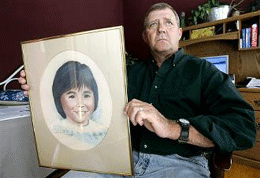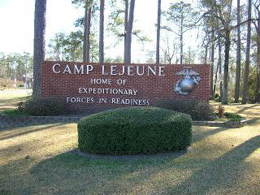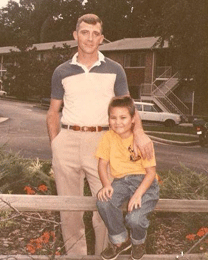Polluted Patriots
Air Date: Week of June 19, 2009

Male breast cancer survivor Jim Fontella, stationed at Camp Lejeune from 1966 to 1967. (Photo: Patty Izzo, Courtesy of Jim Fontella from Michigan)
For decades, the drinking water at a Marine base in North Carolina was tainted with high levels of toxic chemicals. But a new report by the National Academies says the contamination can't be linked to the health problems former residents have suffered. Host Jeff Young talks with a Marine who says his daughter died as a result of contaminated water; an Academy panel member who explains the exposures should be the basis of policy decisions; and an epidemiologist who says the National Academy report is lacking.
Transcript
CURWOOD: ItÂ’s Living on Earth, IÂ’m Steve Curwood.
YOUNG: And IÂ’m Jeff Young.
[MARINE CORPS ANTHEM: “WE WILL FIGHT OUT COUNTRY’S BATTLES ON THE LAND, AIR AND THE SEA,” Marine Corps band “Marine Corps Hymn” from Liberty For All (Altissimo 2007)]
YOUNG: The US Marine Corps' anthem says they'll tackle the enemy on land or water.
But for many thousands of marines who lived on the corpsÂ’ Camp Lejeune in North Carolina the enemy, it turns out, was the water.
From the mid 1950s to the mid 80s drinking water at Lejeune was tainted with a potent stew of toxic chemicals including dry cleaning agents and degreasing solvents from the baseÂ’s machine shops and junkyard.
Master sergeant Jerry Ensminger served nearly a quarter century in the corps, and spent ten years at Camp Lejeune in the 1970s and 80s.

Jerry Ensminger holding a portrait of his daughter. (Courtesy of Jerry Ensminger)
ENSMINGER: I was walking into my living room with a plate of spaghetti to watch the evening news and the reporter said that the chemicals that had been found in Camp LejeuneÂ’s drinking water were linked to childhood cancer, primarily leukemia and that is what my child died of. I dropped my plate right there in the living room floor.
YOUNG: Tell me about your daughter, Janey.
ENSMINGER: Well Janey was one of my four daughters, she was the only one that was conceived on Camp Lejeune, and when Janey turned six years she was diagnosed with acute lymphocytic leukemia. And basically I watched my little girl go through hell for nearly two and a half years and I watched her die a little bit at a time, and she died on 24th of September, 1985, the same year that the Marine Corps decided to take their contaminated wells offline.
YOUNG: Ensminger devoted much of the past decade to learning about the connection between LejeuneÂ’s water, his daughterÂ’s disease, and ailments reported by other Camp Lejeune vets and their families.

Jerry EnsmingerÂ’s daughter Janey before leukemia. (Courtesy of Jerry Ensminger)
The National Academy of Sciences' National Research Council just released its review of the contamination and links to health effects. But those hoping for firm answers were disappointed.
I spoke with Cal Baier-Anderson, a health scientist for the Environmental Defense Fund who was a member of the Academy panel.
BAIER-ANDERSON: The scientific data that's available to us cannot confirm whether their health effects are associated with the exposures that they received while living or working at Camp Lejeune.

(Courtesy of Jerry Ensminger)
BAIER-ANDERSON: My message would be that science can't always answer these very important and critical questions, in fact, rarely do we have conclusive proof. What we do know is that people were exposed to toxic chemicals, and that the toxic chemicals are associated with a wide variety of adverse health effects. And based on these facts that we have in hand we believe that the Navy or Department of Defense should move forward with policy decisions as quickly as possible based on these facts.
YOUNG: Baier-Anderson says incomplete data about water delivery at the base and the complex nature of exposure led the panel to conclude that further study is unlikely to give any better results.
Others say the National Academy could have done more. Boston University professor of public health Richard Clapp has been working with a community advisory panel at Camp Lejeune for three years. Dr. Clapp is well known for his work on high profile water contamination cases and the National Academy asked him to review the panelÂ’s work. He wrote a blistering critique. Dr. Clapp told me heÂ’s especially unhappy with the way the panel characterized the cancer causing potential of the two main contaminants, the solvents tricholorethylene (TCE) and perchloroethylene or PERC.
CLAPP: They said there are no—either sufficient causation or sufficient association relationships they could identify from literature. That's a very conservative reading of the literature, in fact previous National Academy reports have gone further than that, so they're actually taking a step backwards to give such low ranking to these two major chemicals.

Male breast cancer survivor Jim Fontella, stationed at Camp Lejeune from 1966 to 1967. (Photo: Patty Izzo, Courtesy of Jim Fontella from Michigan)
CLAPP: I think they dropped the ball, and during the last administration National Academy committees were not the gold standard. There was a National Academy committee that looked at the EPA's dioxin reassessment and came out with a similar kind of pro-industry, assume the chemical is innocent until guilty type of report. And I'm here to say that I think that that's what this National Academy report was like on the Camp Lejeune studies, it was a give the benefit of the doubt to the pollution, not to the victims.
YOUNG Dr. Clapp says the TCE contamination at Lejeune is among the worst heÂ’s seen. The federal drinking water limit is five parts per billion. At at least one point, a well on Lejeune had 1400 parts per billion.
A half dozen other scientists are joining him in a letter to the Academy outlining their concerns. He thinks federal agencies investigating the Lejeune contamination should continue their work and largely ignore the AcademyÂ’s report.
But other public health advocates see value in the National AcademyÂ’s findings, especially the recommendation that further study should not be an excuse to delay action. Again, Academy panelist Cal Baier-Anderson.
BAIER-ANDERSON I think what people might be missing is this critical message that what we're saying is people were exposed to chemicals in their drinking water and these chemicals are associated with toxic health effects, and that should be the basis of policy decisions, not waiting for some level of causal determination. And I actually think that in many cases the bar to prove causality for situations like this where you have environmental exposures is so high that you know, really having us come out and say 'look if people are exposed,” that's an important fact.
YOUNG A spokesperson for the Marines says officials are still reviewing the AcademyÂ’s report.
Congress is also pushing for action. The SenateÂ’s Armed Services Committee will probably hold hearings. And both North Carolina Senators have given the Navy Secretary until the end of the month to respond to questions about how the contamination was handled.

Jerry Ensminger and his daughter Janey at Camp Lejeune in the '80s. (Courtesy of Jerry Ensminger)
ENSMINGER: “Semper fidelis” is the, official motto. It's Latin and it means always faithful, and I have unfortunately discovered through this fight that the only way that you can make them live up to that is to force them to do it.
I will give this up whenever the organization that I served proudly, the U.S. Marine Corps, lives up to our motto and our slogan, or whenever they pat me in the face with a shovel and blow taps over me.
YOUNG: You can read more about the contamination at Camp Lejeune and Jerry EnsmingerÂ’s campaign at our website, loe.org.
Links
Read more about the National Research Council report on Camp Lejeune.
Check out the web campaign of Jerry Ensminger and other former Camp Lejeune residents.
Living on Earth wants to hear from you!
Living on Earth
62 Calef Highway, Suite 212
Lee, NH 03861
Telephone: 617-287-4121
E-mail: comments@loe.org
Newsletter [Click here]
Donate to Living on Earth!
Living on Earth is an independent media program and relies entirely on contributions from listeners and institutions supporting public service. Please donate now to preserve an independent environmental voice.
NewsletterLiving on Earth offers a weekly delivery of the show's rundown to your mailbox. Sign up for our newsletter today!
 Sailors For The Sea: Be the change you want to sea.
Sailors For The Sea: Be the change you want to sea.
 The Grantham Foundation for the Protection of the Environment: Committed to protecting and improving the health of the global environment.
The Grantham Foundation for the Protection of the Environment: Committed to protecting and improving the health of the global environment.
 Contribute to Living on Earth and receive, as our gift to you, an archival print of one of Mark Seth Lender's extraordinary wildlife photographs. Follow the link to see Mark's current collection of photographs.
Contribute to Living on Earth and receive, as our gift to you, an archival print of one of Mark Seth Lender's extraordinary wildlife photographs. Follow the link to see Mark's current collection of photographs.
 Buy a signed copy of Mark Seth Lender's book Smeagull the Seagull & support Living on Earth
Buy a signed copy of Mark Seth Lender's book Smeagull the Seagull & support Living on Earth

